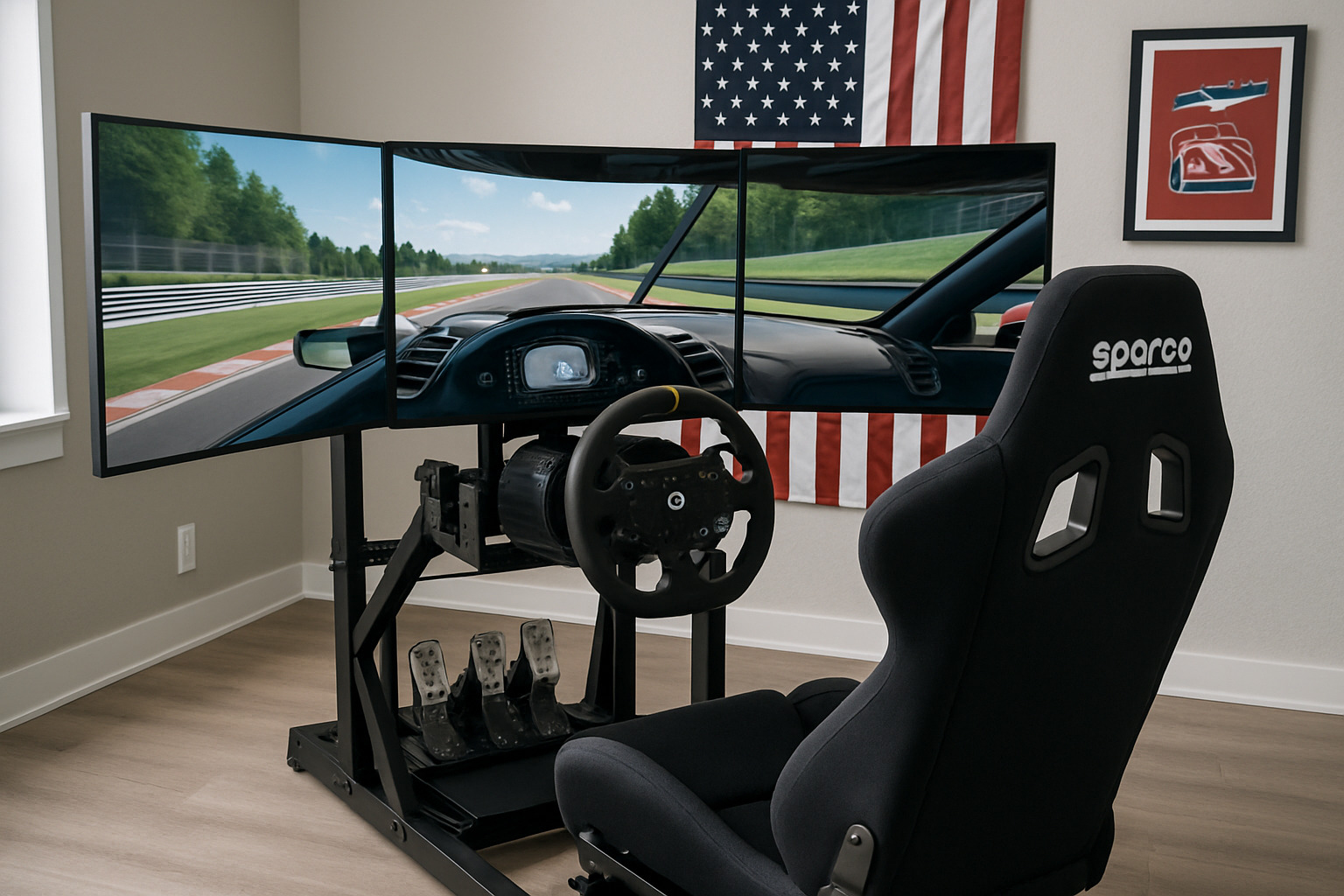Racing simulator training: 10 Powerful Ways for Pro Success 2025
Taking the Virtual Path to Real Racing Excellence
Remember when racing simulators were just fancy video games? Those days are long gone. Racing simulator training has transformed from a hobbyist’s pastime into an essential development tool accepted by drivers across all skill levels. Whether you’re a Formula 1 champion fine-tuning your skills or a weekend enthusiast looking to shave seconds off your lap time, today’s simulators offer an incredible gateway to the racing world without the hefty price tag or risks associated with actual track time.
“Since 1975, the Skip Barber Racing School has been turning drivers into champions and we understand the importance of simulator-based training in a driver’s development.” – Skip Barber Racing School
What Is Racing Simulator Training?
At its heart, racing simulator training is about creating an immersive experience that translates directly to real-world skills. Modern simulators use specialized hardware and software that precisely model how different vehicles handle, respond, and feel. The tracks you’ll race on aren’t approximations – they’re laser-scanned replicas accurate to within fractions of an inch, capturing every bump, banking angle, and surface change.
What makes this form of training so valuable is how it lets you develop critical racing skills in a controlled environment. You’ll work on car control techniques, vision training, and racecraft without the pressure of an actual race situation. The best part? You can analyze detailed performance data after each session, identifying exactly where you’re losing time and what you need to improve.
Perhaps most importantly, simulators allow risk-free training in scenarios that would be dangerous or impossible to recreate in real life. Want to practice wet-weather driving at night? Need to work on recovering from a slide at 120mph? Simulators let you push boundaries safely.
While professional racing teams invest millions in cutting-edge simulator technology, you don’t need a Formula 1 budget to benefit. Even affordable home setups deliver remarkable results. Driver61’s training programs report students improving lap times by up to 0.5 seconds after structured simulator practice, while Sim Racer Academy members typically cut 2-3 seconds from their times on most tracks.
The beauty of modern simulators is their versatility. You can practice on virtually any track worldwide, in any weather condition, any time you want. This makes them an incredibly cost-effective complement to real-world track days. They’re also finding new applications in driver education programs, emergency response training, and finding the next generation of motorsport talent.
Remember – the secret to effective racing simulator training isn’t about spending more on flashy hardware. It’s about practicing with purpose and understanding how to transfer those virtual skills to the real world.

Racing Simulator Training Explained: How Real Is It?
“Is it really like the real thing?” This is what we hear most often when talking about racing simulator training. The answer might surprise you.
Today’s racing simulators have become incredibly sophisticated. The physics engines powering top simulators now model everything from tire temperature to suspension geometry with remarkable accuracy. When you drive on a virtual circuit, you’re experiencing a track that’s been laser-scanned to millimeter precision, capturing every bump, camber change, and surface variation you’d feel on the actual track.
As Driver61, one of the leading sim racing training providers, points out: “Laser-scanned tracks in modern simulators are accurate to within fractions of an inch compared to real-world circuits.”
One fascinating aspect of simulator training is what experts call “deficit training.” Because simulators don’t produce the g-forces you’d feel in a real car, drivers must rely more heavily on visual cues and sound. This actually sharpens these senses, which research from the Journal of Motor Behavior shows transfers positively to real-world driving where these same cues exist alongside physical sensations.
IndyCar champion Tony Kanaan found this firsthand: “In just a week, I was on pace with the top drivers who had been playing iRacing for years!”
Perhaps the most valuable benefit of racing simulator training is the freedom to practice high-risk scenarios without real-world consequences. As Ross Bentley, author of the Speed Secrets series, puts it: “You can crash as much as you want in a simulator and it won’t cost you a dime!”
Racing Simulator Training vs Real-World Driving
While simulators have advanced tremendously, there are key differences between virtual and real racing that every driver should understand.
The most obvious difference is the lack of sustained g-forces in most consumer simulators. Even expensive motion rigs can only hint at the physical demands of a real race car. Your body simply doesn’t feel the same forces pushing against it in corners or under heavy braking.
Tire feedback is another crucial difference. Real drivers feel tire grip through their body and hands in ways that are difficult to replicate. Simulators approximate this through force feedback wheels, but it’s a simplified version of the complex sensations you’d feel on track.
Weather control is where simulators shine. Want to practice in the rain? Or maybe see how your car handles in perfect 72-degree conditions? Simulators let you dial in specific weather scenarios or maintain perfect, repeatable conditions. This controlled environment is ideal for isolating variables and focusing on technique.
The data-rich environment of simulators also accelerates learning. Every lap gives you instant, perfect telemetry that would require expensive equipment in a real car. This immediate feedback loop helps drivers improve faster.
As one real-world driver shared after completing racing simulator training: “Before the training, my best time was 59.875. After the training… I managed to get my time down to 59.405. I feel a lot more confident with my new driving style.”
Limitations of Racing Simulator Training
To use simulators effectively, it’s important to acknowledge where they fall short.
Without expensive motion platforms, your inner ear receives no acceleration feedback. This missing motion cue can make certain techniques harder to master, particularly those related to car balance and weight transfer. Your brain is getting visual information about cornering, but your body doesn’t feel it.
Hardware cost is another consideration. While entry-level setups are relatively affordable, professional-grade equipment quickly becomes expensive. As DPR Motorsport notes, “high-end motion rigs require multimillion-pound budgets to accurately match on-track motion.”
Cybersickness affects some users who experience motion sickness in simulators due to the visual motion without corresponding physical sensations. Interestingly, professional drivers can be more susceptible to this than amateurs because they’re more attuned to vehicle dynamics and notice the discrepancy more acutely.
Practice discipline is perhaps the most overlooked challenge. Without the structure of a track day, maintaining focused practice at home requires self-discipline. Many drivers benefit from structured courses like Driver61’s Sim Racing Masterclass, which provides a framework for improvement rather than just aimlessly lapping.
Despite these limitations, racing simulator training remains one of the most effective tools for driver development when used with purpose and understanding. The key is knowing how to bridge the gap between virtual practice and real-world application.
Building & Optimizing Your Sim Rig
Creating an effective simulator setup isn’t about emptying your wallet—it’s about making smart choices that boost your learning curve. Let’s talk about building a rig that works for both your skills and budget.

The heart of any good racing simulator training setup starts with feel. You need equipment that gives you realistic feedback about what the virtual car is doing. A quality force-feedback wheel tells your hands when the car is losing grip, while load-cell pedals let you develop muscle memory for proper braking technique. As Ray Phillips often says to his students, “A firm brake pedal teaches modulation in ways that soft springs simply can’t match.”
Your visual setup matters tremendously too. Whether you’re running a single monitor, immersive triple-screen setup, or diving into VR, what matters most is setting up your field of view correctly. When your virtual perspective matches what you’d see in a real car, your brain processes speed and distance naturally. This seemingly small detail makes a massive difference in skill transfer.
Don’t overlook the importance of a stable mounting solution either. When you’re wrestling a car through a high-speed corner, the last thing you want is your wheel stand flexing or your pedals sliding away. Your inputs should go directly to the virtual car, not into moving your equipment around!
Hardware Shopping List for Racing Simulator Training
If you’re just getting started, here’s what you’ll need at different price points:
For beginners (around $500-800), a Logitech G29/G920 wheel paired with a simple wheel stand and single monitor will get you learning the fundamentals. This setup connects easily to either a gaming PC or console, making it perfect for testing the waters.
Mid-range enthusiasts typically invest $1,500-2,500 in direct-drive wheels like the Fanatec CSL DD, proper load-cell pedals, and either triple monitors or a VR headset. At this level, you’ll want a dedicated aluminum profile rig for stability and a gaming PC with a decent GPU.
Professional setups ($5,000+) include high-torque direct-drive systems, hydraulic pedal sets, and often motion platforms that hint at real g-forces. But as Tommy Schröter from Baseline Driver Training loves to remind his students: “A fast racing driver can go slow if he needs to. A slow driver can’t go fast when he needs to.” The equipment is just a tool—your skills matter more.
Software & Settings That Matter
Your choice of simulation software shapes your training experience significantly. Many professional drivers gravitate toward iRacing for its competitive online environment and accurate physics. At roughly $7 for base content, it’s accessible despite its subscription model.
Budget-conscious racers often prefer Assetto Corsa or its GT-focused sibling Assetto Corsa Competizione. These platforms offer excellent physics and tremendous mod support, expanding your training options. For those particularly focused on developing car feel, rFactor 2’s advanced tire modeling provides nuanced feedback that’s hard to match.
When setting up your software, prioritize frame rate over pretty graphics. A smooth, consistent visual experience reduces input lag and helps your brain process information more effectively. Spend time fine-tuning your force feedback settings too—you want enough detail to feel what the car is doing without distracting noise or clipping effects that mask important sensations.
FOV, Seat & Ergonomics Tuning
The ergonomics of your racing simulator training setup might seem like a minor detail, but they’re crucial for skill development. Your field of view setting should be mathematically correct based on your monitor size and viewing distance. Yes, this often feels claustrophobic at first—most newcomers set their FOV too wide—but correct settings help you accurately judge braking points and cornering speeds.
Your seating position should mirror a real race car. Position your eyes roughly level with the horizon line, with arms slightly bent when your hands sit at 9 and 3 o’clock. When you extend your arms, your wrists should rest naturally on top of the wheel. Your legs should remain slightly bent even when fully pressing the pedals.
Speaking of pedals, their travel and resistance should ideally match the type of car you’re simulating. GT cars typically have longer pedal travel, while formula cars feature shorter, stiffer pedals. As Ross Bentley points out, “Pedal firmness is critical for realistic modulation; basic pedals can be upgraded with aftermarket springs.” These small modifications can dramatically improve how effectively your practice transfers to real driving.
Consistency between your simulator and real-world driving positions helps build muscle memory that transfers seamlessly to the track. Your body remembers positions and movements—give it the right patterns to learn from!
Pro-Level Skills and Drills to Practice
Once your simulator is set up properly, it’s time to focus on developing specific skills. Racing simulator training excels at building these fundamental abilities:

Vision & Awareness Drills
Vision is perhaps the most transferable skill between sim and real racing. Professional drivers consistently emphasize the importance of looking far ahead.
When practicing your look-ahead technique, choose a technical section of track and gradually extend your visual focus with each lap. You’ll be amazed how your racing line naturally improves as you train yourself to look further down the track.
“Vision is important when driving on track whether it’s real-world or sim because you need to give yourself the right information at the right time,” explains Driver61’s coaching material.
Developing a proper scanning pattern is equally crucial. Train yourself to move your eyes fluidly between reference points: from braking point to turn-in point, then to apex, exit point, and on to the next braking point. Recording your sessions to review where you’re looking can reveal surprising habits you never knew you had.
For peripheral awareness, try placing small colored objects at the edges of your monitor(s) and practice noticing color changes while maintaining forward focus. This simple drill develops the peripheral vision needed for wheel-to-wheel racing where sensing other cars’ movements is critical.
VR headsets offer unique benefits here, as they allow natural head movement and depth perception. Many drivers find that skills developed in VR transfer particularly well to real cars, thanks to the immersive spatial awareness they provide.
Pedal Mastery & Brake-Blending
Braking technique is where many drivers find the biggest time gains. Racing simulator training allows unlimited practice of these techniques without worrying about tire or brake wear.
The load trace exercise is a game-changer for many drivers. Apply maximum brake pressure at the beginning of braking, then gradually reduce pressure (trail brake) as you approach the apex. Using telemetry, verify your brake trace forms a smooth downward slope, not jagged steps. This single technique can transform your cornering.
“In order to trail brake effectively, you should be applying the most amount of brake pressure when the car is going the fastest, and releasing the pressure as you approach the corner,” explains Ray Phillips.
For threshold braking practice, find a straight with a hard braking zone and work on braking at the absolute limit before lockup. The beauty of simulators is you can push this limit repeatedly without flat-spotting real tires. Your telemetry should show you’re using 99-100% of available grip.
The skidpad drill is another valuable exercise – create a circular skidpad in the simulator and practice maintaining a constant radius while gradually increasing speed. You’ll develop a feel for how brake and throttle inputs affect the balance of the car in a way that’s directly transferable to the track.
These drills build muscle memory that translates seamlessly to real cars. One sim racer who applied these techniques shared: “Since I’ve learned in detail how vision helps time driver inputs, I’ve placed 2nd in 6h ELMS Monza & 6h Sebring, won a solo victory in VLN, and am now competing above my iRating in LMP1.”
Steering Smoothness & Grip Fishing
Smooth, precise steering inputs are the hallmark of fast drivers. Racing simulator training provides the perfect environment to develop this finesse without the real-world costs of pushing too hard.
Focus on making one smooth steering input for each corner – the single-input turn-in. Avoid sawing at the wheel or making multiple corrections, which scrubs off speed. Recording and reviewing your steering input traces can be eye-opening; many drivers are shocked to see how jerky their inputs actually are.
“Execute one smooth increase in steering angle when turning into a corner,” advises Driver61’s coaching material, emphasizing the link between smooth inputs and consistent lap times.
Deliberately inducing under and oversteer is another valuable practice technique. Create understeer by turning in too fast, then experiment with oversteer by applying too much throttle on exit. Learning to catch and control these slides builds the feel for the car’s limits – a skill that pays dividends on track.
Wet-weather practice is particularly valuable in simulators. Many sim platforms offer realistic wet conditions that allow you to practice the delicate car control needed in the rain. “Using fluid steering inputs in a simulator to mirror real-car behavior” becomes especially important in these low-grip situations, according to coaching experts who’ve helped drivers master these conditions.
Racecraft & Strategy Scenarios
Beyond pure driving technique, Racing simulator training excels at developing racecraft—the art of racing wheel-to-wheel.
Start procedure practice is something you simply can’t do enough of in real life due to cost and time constraints. In your simulator, set up AI races with full grids and focus on clean, consistent launches. Practice finding gaps in the first corner melee without risking your real car or others.
Identifying passing zones becomes second nature with enough focused practice. Study where overtaking opportunities exist on each track, then practice setting up passes several corners in advance. Work on clean execution that doesn’t compromise your exit – the mark of a truly skilled racer.
Defensive line training is equally important. Take the defensive (inside) line into key corners and practice maintaining this position while under pressure. You’ll learn to recognize when defending costs too much time – sometimes giving up a position to set up a counter-attack is the faster strategy.
Fuel and tire management becomes increasingly important in longer races. Run full-length races to practice conserving resources and experiment with different driving styles to extend tire life. Techniques like lift and coast can save crucial fuel without sacrificing much lap time.
“Leverage fluid driving style to increase grip and cornering speed,” notes one coaching program, highlighting how smooth inputs preserve tires over a race distance – a lesson that pays dividends whether you’re racing for 20 minutes or 24 hours.
For more insights into advanced driving techniques that complement your simulator training, check out our guide to Advanced Car Driving Techniques and learn more about the science behind racing at Motorsport Science Foundation.

From Screen to Circuit: Applying Simulator Gains
The ultimate goal of racing simulator training is to improve real-world performance. Here’s how to ensure your simulator skills transfer effectively to the track:
Data Overlays
Modern simulators generate the same telemetry data as real race cars. Learning to read and interpret this data is a skill that transfers directly to the paddock.
Lap Comparison
Record your best laps and compare them to reference laps from faster drivers. The ability to analyze where time is gained or lost is invaluable both virtually and in reality.
Mental Rehearsal
Use simulator sessions as visualization exercises. Before a real track day, run laps in the simulator while consciously noting reference points, braking zones, and racing lines that you’ll use on track.
Cost Savings
By mastering a track in the simulator first, you’ll extract more value from expensive real-world track time. As one driver notes, “In about 20 minutes, using Ross’ methods, I knocked 1.5 seconds off my best lap time at Monza. And I was more consistent.”
Confidence Boost
Arriving at a new track with hundreds of virtual laps already completed provides a significant psychological advantage. You’ll feel familiar with the layout and ready to focus on fine-tuning rather than learning basics.
Using Telemetry to Bridge Sim and Track
Telemetry is the common language between simulator and real-world driving. Systems like VBOX and MoTeC are used in both environments, making data analysis a perfectly transferable skill.
“Export your simulation data into ATLAS or MoTeC, view brake, throttle, and steering traces, and compare them against ideal traces to evaluate your trail braking technique,” advises Ray Phillips.
Key metrics to focus on include:
- Braking points and release patterns
- Throttle application timing and progression
- Steering angle and rate of input
- Speed at corner entry, apex, and exit
- Line consistency over multiple laps
Professional drivers often overlay simulator and real-world data to identify areas for improvement. “iRacing partners with McLaren to allow direct export of telemetry into ATLAS software,” making this process seamless for serious drivers.
Integrating Racing Simulator Training into Driver Education
Racing simulator training is increasingly finding applications beyond competitive motorsport:
Law Enforcement Programs
Police departments are adopting simulator training for pursuit and emergency response scenarios. The CODE 3 Emergency Driving program uses simulators to train officers in high-pressure driving situations without risk.
HPDE Schools
High Performance Driver Education programs now commonly use simulators to introduce concepts before students get in a real car. “Virtual Track Days” serve as a soft introduction for novices, building confidence before they reach the actual circuit.
Emergency Response
First responders use simulators to practice high-speed driving in various conditions. “Emergency response units practicing high-speed pursuit and obstacle avoidance in virtual scenarios” build skills that save lives in real emergencies.
“Sim training allows for unlimited, risk-free practice of advanced car control techniques, which would be impractical or unsafe to attempt repeatedly in real life,” notes one training provider, highlighting the safety advantages of this approach.

The Future of Racing Simulator Training & Next Steps
The world of racing simulator training continues to evolve rapidly. Here are the innovations we’re watching closely:
AI Coaching
Machine learning algorithms are beginning to analyze driving data and provide personalized coaching feedback. These systems can identify patterns and improvement opportunities that might escape human observation.
Eye-Tracking
New systems incorporate eye-tracking technology to ensure drivers are looking in the right places at the right times. This technology provides objective feedback on vision techniques that were previously difficult to measure.
Haptic Suits
Beyond motion platforms, haptic feedback suits can provide physical sensations across the body, helping to fill the g-force gap between simulators and real cars.
Cloud Simulators
Cloud-based simulation platforms are making high-end physics engines accessible without expensive local hardware, democratizing access to quality training.
Esports Pathways
Formal pathways from sim racing to real-world competition are emerging, with manufacturers like Porsche, BMW, and Gran Turismo’s GT Academy leading the way.
Sustainability
As motorsport faces pressure to reduce its environmental impact, simulators offer a way to maintain driver development while reducing carbon footprints.
Getting the Most From Every Session
To maximize the effectiveness of your racing simulator training, follow these best practices:
Goal Setting
Before each session, define 1-2 specific skills to focus on. This targeted approach yields better results than general practice.
Blocked vs Random Practice
Begin with blocked practice (repeating the same corner or section) to master a technique, then progress to random practice (full laps) to cement the skill under varying conditions.
Cooldown Review
After each session, review your telemetry and video. Identify what went well and what needs improvement while the session is fresh in your mind.
Coach Feedback
Consider working with a professional coach, even for just a few sessions. As RaceCraft1 notes, “If you have no prior experience, you’ll feel comfortable and relaxed with our instruction. Seasoned veteran or professional racer? You’ll be inspired by RaceCraft1 expert insight.”
Frequently Asked Questions about Racing Simulator Training
Is a motion rig necessary?
One question we hear all the time from newcomers to racing simulator training is whether they need to invest in an expensive motion rig. The short answer? Absolutely not!
While those fancy moving platforms you see on YouTube might look impressive, they’re far from essential for effective training. Many professional drivers actually prefer training on static rigs, focusing instead on the visual cues and force feedback through their steering wheel.
DPR Motorsport makes an interesting point about this, noting that they deliberately choose not to use motion systems because “high-end motion rigs require multimillion-pound budgets to accurately match on-track motion.” Unless you’ve got a spare million lying around, you’re better off investing in quality force feedback, accurate pedals, and proper field of view settings.
Think of it this way: your eyes and hands gather most of the information you need while driving. Get those inputs right first, and you’ll see much bigger improvements than splurging on a motion platform that might actually teach you some bad habits.
How much practice time is optimal per week?
Finding the sweet spot for practice time can be tricky. Too little and you won’t build consistency; too much and you risk burnout or developing sloppy habits from fatigue.
Most coaching programs we’ve researched recommend 30 minutes to 1 hour of focused practice, 3-5 days per week. Baseline Driver Training puts it well: “30 minutes of practice, 3–5 days per week yields significant learning.” This approach prevents fatigue while maintaining the high concentration levels needed for effective skill development.
Quality trumps quantity every time. One focused 30-minute session where you’re working on a specific skill (like trail braking or throttle control) will yield far better results than mindlessly turning laps for hours. Many pros actually use a timer to ensure their practice sessions stay short and focused!
Set specific goals for each session, take breaks when your concentration starts to wane, and you’ll see much better progress than those marathon eight-hour sim sessions that leave you mentally drained.
Do sim skills really cut seconds off real lap times?
This is perhaps the million-dollar question – does all this virtual practice actually make you faster in a real car? Based on our research and numerous driver testimonials, the answer is a resounding yes!
The evidence is pretty compelling. One driver reported: “In about 20 minutes, using Ross’ methods, I knocked 1.5 seconds off my best lap time at Monza.” That’s a massive improvement in the racing world, where tenths of a second often separate the podium from the pack.
Sim Racer Academy members have consistently reported shaving 2-3 seconds off their lap times on most tracks after applying simulator-developed skills to real-world driving. Even more conservative estimates from Driver61’s programs show “lap time improvements of up to 0.5 seconds after structured simulator training.”
The key phrase here is “structured, deliberate practice.” Random hotlapping won’t cut it. The real gains come when you focus on transferable skills like vision techniques, brake modulation, and racing lines – elements that work exactly the same way in both virtual and real environments.
What’s particularly interesting is that many drivers report the biggest improvements coming not from car control skills, but from the mental aspects of racing that simulators help develop: confidence at new tracks, the ability to quickly identify reference points, and improved decision-making under pressure.
Conclusion
Racing simulator training has come a long way from its humble beginnings as a gaming activity. Today, it stands as an essential tool for driver development at every level of motorsport. While the technology continues to evolve at a rapid pace, the core benefit remains unchanged: the ability to practice racing techniques repeatedly without risk, developing skills that transfer directly to real-world driving.
Here at Car News 4 You, we’ve been fascinated by this evolution. We believe simulators represent one of the most important advances in driver training methodology in recent decades. What’s particularly exciting is how this technology has been democratized – skills that were once only available to professionals with substantial budgets are now accessible to enthusiasts of all levels.
The beauty of racing simulator training lies in its versatility. Whether you’re preparing for your first-ever track day, working to shave seconds between race weekends, or simply enjoying the thrill of virtual competition from home, a thoughtful approach to simulator practice can yield impressive results on the track.
IndyCar champion Tony Kanaan’s experience speaks volumes: “In just a week, I was on pace with the top drivers who had been playing iRacing for years!” With the right mindset and methods, you too can harness simulation power to become faster and more consistent – both in the virtual world and on real asphalt.
Simulators aren’t just a fallback option when you can’t make it to the track. They represent a powerful complement to real-world driving that accelerates your learning curve, builds confidence in your abilities, and ultimately makes you a more complete racing driver.
The skills you develop – from vision techniques to brake modulation, from racecraft to mental preparation – create a foundation that pays dividends when you finally slide into the driver’s seat of a real race car. And with each passing year, the gap between virtual and reality continues to narrow.
So whether you’re building your first sim rig or upgrading to professional equipment, the most important factor isn’t the cost of your setup – it’s how deliberately you practice and how effectively you transfer those skills to the real world. That’s where the true value of racing simulator training lies, and why it has become an indispensable tool for drivers at every level of the sport.








1 thought on “The Professional’s Approach to Racing Simulator Training”
Pingback: Life in the Fast Lane: Your Roadmap to a Racing Career - Car News 4 You
Comments are closed.